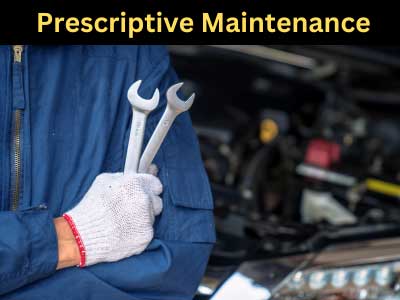Key Takeaway
Prescriptive maintenance goes beyond predicting equipment failures—it provides specific actions to prevent them. Using advanced technologies like machine learning and artificial intelligence, it not only predicts potential issues but also recommends the best course of action to address them.
The process begins with collecting real-time data from equipment. This data is analyzed to foresee failures, and prescriptive analytics then suggest actions, such as part replacements or adjustments. By implementing prescriptive maintenance, companies can minimize downtime, optimize schedules, and extend machinery life, improving overall operational efficiency and cost savings.
Introduction to Prescriptive Maintenance
Prescriptive maintenance goes beyond predictive maintenance by not only predicting when equipment might fail but also recommending corrective actions. It integrates data analytics, machine learning, and artificial intelligence (AI) to make data-driven decisions that optimize asset performance.
This approach is more proactive, as it helps organizations avoid costly downtime by prescribing the most efficient ways to maintain equipment. The system suggests actions, such as adjusting settings, repairing components, or scheduling maintenance based on real-time data. Prescriptive maintenance offers a smarter, more efficient way to manage industrial operations, ensuring that machinery stays in top condition.

How Prescriptive Maintenance Builds on Predictive Methods
Predictive maintenance identifies potential equipment issues by analyzing historical and real-time data from sensors. However, it stops short of offering specific recommendations. Prescriptive maintenance takes predictive insights a step further by using advanced algorithms to provide clear and actionable suggestions for addressing potential failures. For example, while predictive maintenance may warn that a compressor is likely to fail soon, prescriptive maintenance will advise exactly which part needs replacement or which parameters need adjustment to prevent failure.
The key difference lies in how each method handles data. Predictive maintenance focuses on detection, while prescriptive maintenance focuses on resolution. This proactive approach helps businesses not only avoid downtime but also optimize resource allocation by scheduling maintenance tasks only when necessary. By moving from reactive to proactive solutions, prescriptive maintenance ensures smoother, more efficient operations.
The Role of AI in Prescriptive Maintenance
Artificial intelligence (AI) plays a critical role in prescriptive maintenance by processing vast amounts of data quickly and accurately. AI analyzes patterns in sensor data, such as vibration, temperature, and pressure, to predict equipment failures. But more importantly, AI enables prescriptive maintenance systems to recommend specific actions, such as adjusting machine parameters or replacing a component.
AI-driven prescriptive maintenance is constantly learning from new data, improving its recommendations over time. As the system becomes more sophisticated, it can make more precise predictions and offer better solutions. For instance, AI might suggest a minor adjustment to avoid a major issue down the road, improving the overall efficiency of equipment. The integration of AI into prescriptive maintenance helps companies reduce maintenance costs, extend equipment lifespan, and boost overall productivity.
By automating maintenance decision-making through AI, businesses can ensure machines are maintained optimally, leading to fewer breakdowns and more efficient use of resources. This results in significant cost savings and improved reliability.
Key Benefits of Implementing Prescriptive Maintenance
Implementing prescriptive maintenance in industrial settings comes with numerous benefits, particularly in reducing equipment downtime and improving maintenance efficiency. One of the most significant advantages is the reduction in unexpected failures, as prescriptive maintenance proactively suggests solutions before failures can occur. This leads to fewer costly repairs and less downtime for equipment, ensuring smooth and continuous operations.
Another benefit is resource optimization. With prescriptive maintenance, maintenance tasks are only performed when necessary, avoiding over-maintenance or under-maintenance. This not only reduces labor costs but also conserves spare parts and other resources, leading to significant cost savings. Furthermore, by making precise, data-driven recommendations, prescriptive maintenance enhances the safety of industrial environments by preventing hazardous equipment malfunctions.
Industries such as manufacturing, oil and gas, and transportation are already seeing improvements in equipment reliability and operational efficiency through prescriptive maintenance. By adopting this advanced maintenance strategy, businesses can increase equipment uptime, extend asset lifespan, and improve overall productivity.
Industries Leading the Way in Prescriptive Maintenance Adoption
Industries that rely heavily on machinery and equipment, such as manufacturing, energy, and transportation, are leading the adoption of prescriptive maintenance. In these industries, equipment downtime can result in substantial financial losses, making reliable and efficient maintenance strategies essential. For instance, in the manufacturing sector, prescriptive maintenance helps ensure that machines operate efficiently, reducing the risk of production delays and costly breakdowns.
In the energy sector, prescriptive maintenance is being used to monitor critical infrastructure, such as turbines and power grids. With the ability to predict potential failures and recommend preventive measures, energy companies can avoid costly outages and extend the lifespan of their equipment. Similarly, in transportation, prescriptive maintenance is utilized to maintain fleets of vehicles, optimizing their performance and reducing the need for unscheduled repairs.
As industries continue to embrace digital transformation and automation, prescriptive maintenance is becoming a key tool in optimizing operational efficiency and reducing downtime. By using data and AI to make smarter maintenance decisions, companies can improve reliability, reduce costs, and ensure long-term operational success.
Conclusion
Prescriptive maintenance represents the next step in maintenance technology, offering businesses the ability to prevent failures while also providing actionable solutions to avoid them. By combining predictive insights with specific, data-driven recommendations, it reduces equipment downtime, optimizes maintenance schedules, and ensures that resources are used efficiently. As more industries adopt this technology, prescriptive maintenance will play a crucial role in enhancing operational efficiency, improving asset longevity, and reducing costs.
